Ch.11 Emotions
1/50
There's no tags or description
Looks like no tags are added yet.
Name | Mastery | Learn | Test | Matching | Spaced |
|---|
No study sessions yet.
51 Terms
Emotions
Emotions permit persons to react to situations in such ways that make their thoughts & feelings readily apparent(to others and oneself), when nothing is said.
Actions Alter Emotions
People hold a pen in their teeth, who have therefore forced to smile were mor likely to report amusement than were people with a pen in their lips, who therefore cold not smile
FACIAL FEEDBACK HYPOTHESIS
Facial expressions are not only the result of our emotions but can also influence our emotional experience
Emotions can:
ENHANCE COMMUNICATION with others and with oneself;
Color experience by FOCUSING ONE”S ATTENTION in certain directions or MOTIVATE a person to behave in particular ways
Psychologists define emotion in terms of a…
TRIPARTITE MIND-BODY INTERACTION
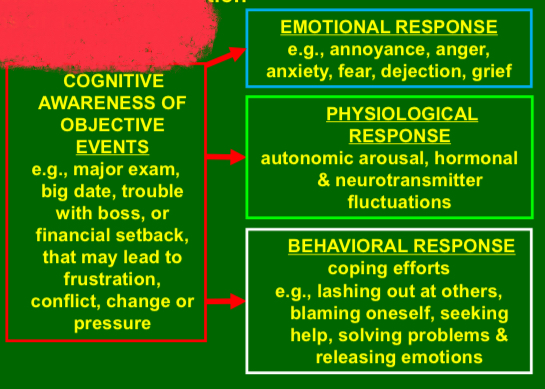
The brain uses the…
AUTONOMIC NERVOUS SYSEM to convert the physiological response occurring during emotional expression
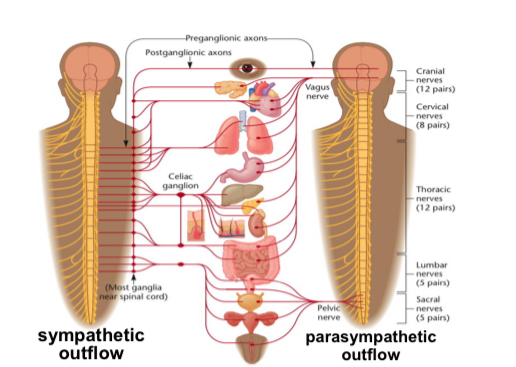
Theories of Emotion
Common Sense Theory
The common sense theory of emotion suggests that initially we perceive an emotion & from the emotion, a specific patter of autonomic arousal & skeletal action

James Lange Theory of Emotion (1884)
The James-Lange theory of emotion suggest that the autonomic arousal & skeletal action occurs first
Then the emotion that occurs is the label that we give the specific arousal of the organs & muscle
The greater the physiological arousal the more intense the emotion
Main contribution: the experience of emotion may involve “reading” the state of one’s own body

The Cannon-Bard theory of emotion (1927)
the emotion is produced in the brain alone.
An emotion is mediated via brain activity following recipes & processing of sensory information
Thus, the emotional cognition & the autonomic arousal & skeletal action occur simultaneously

The Schafer-Singer 2 factory theory (1962)
relatively non specific feelings of physiological arousal occur & then emotional labels are attributed to them
These attributions occur by CNS systems that interpret the current social, physical & cognitive situation
So the physiological response is a cue to the brain that something important may be happening to us

Schacter-Singer - The vitamin “Suproxin” study
Schacter-Singer - The vitamin “Suproxin” study: Hypothesis
Would participants be deceived into experiencing n emotion based on the available “cognitive circumstance” in the absence of an appropriate explanation for arousal?
Schacter-Singer - The vitamin “Suproxin” study: Study Design (2 × 3 × 2)
epinephrine vs placebo
Informed vs ignorant vs misinformed
Cognitive circumstance: eutrophication vs angry confederate
Measured self-reported mood before & after being with the confederate
Schacter-Singer - The vitamin “Suproxin” study: Findings
Placebo - reported no emotional change.
Epinephrine - persons who had no explanation for their physical arousal (i.e., in ignorant & misinformed conditions), looked to their context for an explanation for what they were experiencing
If they were with the happy stooge, they felt happy
If they were with the angry stooge, they felt upset
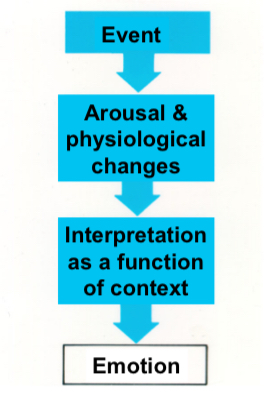
Schacter-Singer - The vitamin “Suproxin” study: Conclusions
Interpretation of physical states (facial expressions, physiological changes) are key components of emotion mechanics
Interpretation of th situation context is a key determinant of emotion mechanics
However, the brain can also generate emotion without added input from the body e.g., quadriplegic (paralyzed persons feel emotions
Brain Representations of Emotion
emotional experiences arouse many areas of the brain
the LIMBIC SYSTEM & THE FOREBRAIN areas are considered critical for producing emotion
PET & fMRI studies also suggest many of the other areas of the cerebral cortex, especially the frontal & temporal lobes, are activated during an emotional experience
The right hemisphere seems to be more responsive to emotional stimuli than the…
The right hemisphere seems to be more responsive to emotional stimuli than the left
Viewing pictures of emotional facial reactions (anger, fear, happiness, disgust, sadness) Tends to activate right temporal cortex more than left
Damage to the right temporal cortex causes deficits in identifying emotional expressions of others
Limbic System
The limbic system consists of a number of interlinked structures that form a border around the brain stem
Mediates emotion, motivation, aggression, learning and memory
James Papez (1883-1958)
Papez hypothesized that EMOTIONAL EXPERINCE was primarily determined in the cingulate gurus & prefrontal cortical region as
But EMOTIONAL EXPRESSION was thought not to be a function of one specific brain center but the result of a circuit of limbic system structures
Phineas Gage
A railroad foreman for Rutland & Burlington Railroad in central Vermont in 1848
Suffered a terrible accident — an explosion sent a tamping rod through his brain
Connections from frontal lobe to limbic system were severed by the tampering rod
What happened to Phineas Gage because of the rod
Normally inhibitory connections from frontal lobe to the limbic system suppress its emotional suggestions
Serotonin is the neurotransmitter
Low brain serotonin release is associated with history of impulsiveness, violent crimes, depression, & suicidality
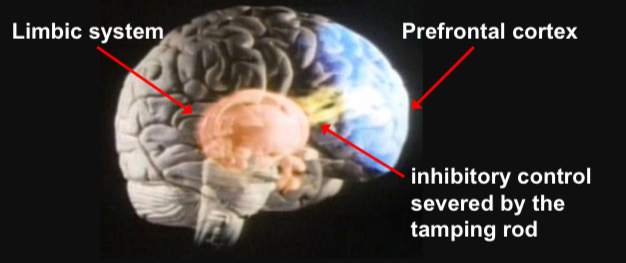
What happened to Phineas Gage because of the rod PT.2
Damage to the prefrontal cortex can impair decision making & results in hyper-emotionality
Gage’s case is an illustration of the CNS organizational principle that HIGHER ORDER STRUCTURES INHIBIT LOWER ORDER STRUTURES
The lost of prefrontal cortex control leads to impulsive decision-making without pausing to consider consequences
Stems from failure to anticipate the unpleasantness of an outcome
Attention Deficit Hyperactivity Disorder (ADHD)
6.1 million in Us; 1 in 8 boys; 1 in 18 girls
Core symptoms include:
Distracitbility, impulsiveness, hyperactivity; especially in tasks involving executive control (response inhibition, working memory)
Name may be a misnomer because children usually have very good attention spans
Decreased connectivity in a fronto-straieto-parieto-cerebellar network
Delay in PFC cortical development
treated with seretonin reuptake inhibitors (SSRI) & methylphenidate (Ritalin) to block reuptake of seretonin & dopamine → enhances inhibition of limbic system & motor cortex
Representation of Emotion as 3-Dimensions
Right-hemisphere junction where the temporal lobe meets the parietal cortex is activated when watching an emotionally charged movie (Lettieri et al., 2019). •
Researchers used moment-to-moment ratings & fMRI to show that emotions are coded within 3-dimensions:
Polarity = pleasure vs. displeasure
Intensity = high vs. low
Complexity = conflict (inner conflict & ambivalence) vs. unambiguous (more certain emotion)
Amygdala & Fear
The amygdala has been implicated as a key structure in the mediation of fear
Amygdala responds more strongly to an angry face directed away & to a rightened face directed toward you
Amygdala responds more strongly to expressions that are more difficult to interpret
Amygdala
Damage to the amygdala interferes with:
Learning of fear responses
Retention of previsult learned fear responses
Interpreting stimuli with emotional consequences, in particular stimuli that are threatening
Many of our body’s alarm circuits are grouped together & linked to the amygdala
Informs of potential dangers in the environment
Diagram:

Summary
Emotions include a tri-partite process (affect, physiological arousal, behavior) that involves an interaction of the prefrontal cortex & the limbic system & the evaluation of the emotionally provocative experiences in terms of:
Polarity, intensity & complexity;
Detection of bodily responses (nonverbal behavior, physiological arousal);
appraisal of the context of these events & their meaning (Schafer & Singer)
Behavioral Medicine
The field of BEHAVIORAL MEDICINE is an extension of biopsychology onward health
It emphasizes the effects of emotions & other behaviors (diet, exercise, smoking, etc) on health & illness
One major focus of interest in behavioral medicine research has been the picture relationship between LIFE DISTRESS (e.g., dysphoria, perceived stress, anxiety) & DISEASE.
Behavioral scientists study the potential ways stress may affect diseases pathophysiology
Sources of Stress
Come from many directions, including: school, family, friends, strangers, & authorities
Major life events
Catastrophes
Daily hassles
Environmental (e.g., noise, population crowding & traffic)
Job related
Working Hypothesis of the Stress-Disease Relationship
Chronic &/or repeated acute stress adversely affects multiple physiological systems & contributes to disease pathophysiology more readily in susceptible persons
The Stress Stimulus
These are common elements to situations that may elevate stress responses in everyone
Novelty
Unpredictability
Threat to the ego
Loss of control
The Stress Response
Walter Cannon’s research (1932) on the “FLIGHT OR FIGHT RESPONSE” stimulated extensive research examine the bodily responses to stressors (e.g., temp extremes, O2 deficit, negative emotions)
This research helped to show that the mind & the body are not discrete & unrelated but in fact greatly influence each other
Walter viewed stress as a gift to be used wisely, enabling people to meet & overcome adversity
His research showed that major emotions involve the excitation of the sympathetic nervous system
Stress
The process by which we perceive & respond to events that are perceived as harmful, threatening or challenging
Stress is identified as one of the 10 leading occupational health problems in the US
Stress is a part of life
In fact, without stress our lives would be dull
But, WHEN STRESS OVERTAXES OUR COPING RESOURCES, it can damage our health
Stressor
Any event or situation that triggers coping adjustments
Allostasis
The adaptive process of achieving stability, or HOMEOSTASIS, through physiological or behavioral chan → is essential for maintaining internal viability amid changing conditions
Allostatic load
Cumulative long-term effects of the body’s physiological response to stress
Both repetitive acute & prolonged chronic stressors may contribute
Stress Induces the…
Flight or Fight Response
This prepares the body for handling brief emergencies
The response is mediated by the activation of hypothalamic-pituitary-adrenal cortex (HPAC) axis & the sympathetic-adrenal medulla (SAM) axis
Ex:
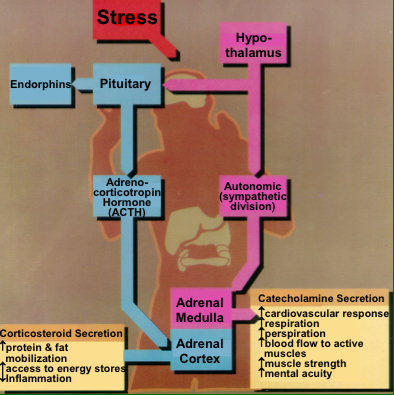
Hans Selye (1979) & Stress
Hans Selye (1979) defined stress as the NON-SPECIFIC RESPONSE of the body to any demand made upon it
Studied influence of stress on ability to cope with & adapt to the pressures of injury & disease
Discovered that a variety of ailments manifested in many similar symptoms, which he attributed to the body’s efforts to response to stressed of being ill
He hypothesized that threats on the body activate a general response to stress called the GENERAL ADAPATION SYNDROME
When stressors are viewed as challenges, then they can lead to growth & enhanced functioning → he termed this “eustress” (good stress)
General Adaptation Syndrome Stages
Alarm Stage:
Acute increase in sympathetic nervous system activity
Resistance Stage:
sympathetic repsponse declines, the adrenal cortex releases cortisol & other hormones that ENABLE THE BODY OT MAINTAIN PROLONGED ALERTNESS, FIGHT INFECTION & HEAL WOUNDS
Exhaustion Stage:
Occurs after prolonged stress & is characterized by inactivity, vulnerability, & decreased energy to sustain heightened responses
General Adaptation Syndrome: General Info
Long-term, inescapable stressors activate the GENERAL ADAPTATION SYNDROME,
Which in short-term is helpful, but in the long-term is harmful to our health
HPAC AXIS
The HPAC axis becomes the dominant response to prolonged stressors
Hypothalamus
Activation of the Hypothalamus induces the pituitary gland to secrete adrenocorticotropic hormone (ACTH)
ACTH
Stimulates the adrenal cortex to secrete cortisol
Cortisol
Helps to mobilize energies to combat a difficult situation; salivary levels are used as in index of stress
The Transaction Model (Lazarus & Folkman, 1984)
The STRESS depends as much on how an event is appraised as it does on the stressor event itself
Richard S. Lazarus, “Our emotions & thoughts are inextricably linked.”
Diagram:
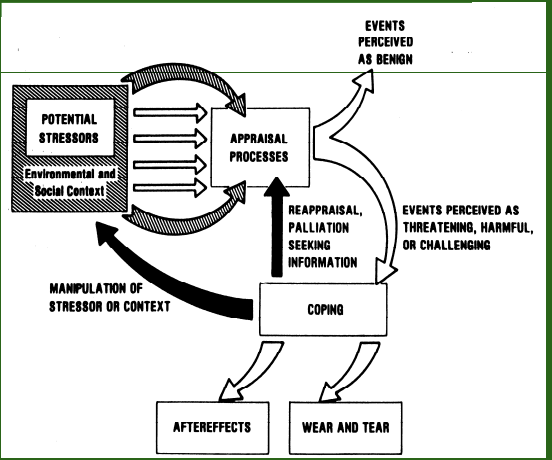
Psychoneuroimmunology
Study of the relationship of psychological & behavioral factors, immunity & changes in health status
Ader & Cohen (1975)
They were studying conditioned taste aversion to a sweet water solution after painting with a nausea-inducing drug using Pavlovian conditioning
Over the course of training, the rats learned to avoid the sweet water
But ader discovered a problem that the rats appeared to have a high infection prevalence
Puzzled by this development, they then force fed the rats with the sweet water, & a number of them became very sick
Then Ader discovered that the number of infection-fighting immune cells was significantly reduced
Ader & colleagues were the first to show that the CNS is capable of controlling the immune system
Ex:
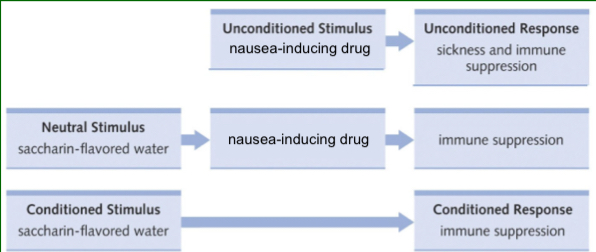
Subsequent Studies to Ader
Jemmott et al (1983)
dental students displayed decreased antibody (lgA in saliva) during EXAM STRESS than during vacations
Kiecolt-Glaser et al (1984
LONELY students had poorer immune function than non-lonely students during exams
Schleifer et al (1983)
BEREAVEMENT acutely depresses immunity in widowers
Cohen et al (1998)
exposed subjects to cold virus; those having 2 month or more of increased PERCEIVED STRESS were ore likely to become infected
Immune response to infection
The immune response to infection involves inflammation as a necessary & helpful process
Ex:
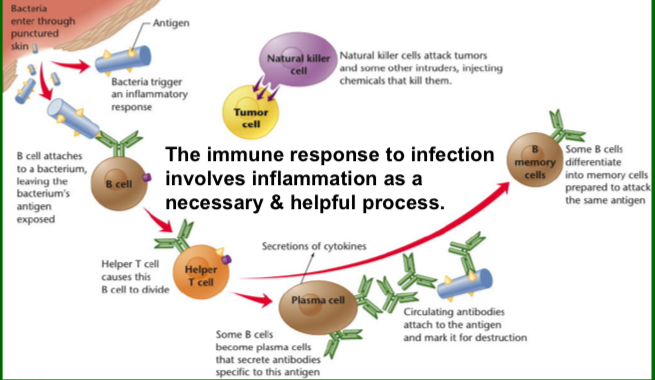
Stress & inflammation
Acute stress induces pronounced immune cellular migration into circulation, which helps to combat infection
Contained within the stress response is the release of substances that injures cells & causes the relapse of inflammatory
Inflammatory cytokines feed back to the brain & may produce symptoms of illness,
E.g., fever, sleepiness, lack of energy, etc..
sleep & inactivity are the body’s way of conserving energy to fight illness
Stress, inflammation & Negative Emotions
Inflammatory substances are linked with depression, fatigue & other negative emotions
Negative emotions contribute to greater risk for prolonged infection & delayed wound healing, which further fuels sustained inflammatory substance release